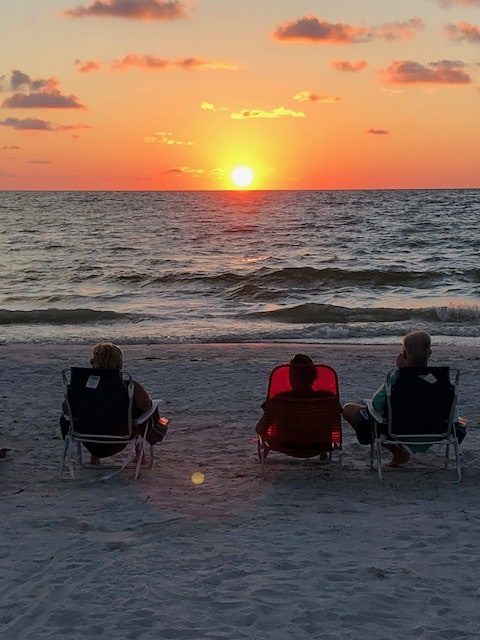Writing about murder must be in my DNA. Growing up in St. Petersburg, Florida, the setting for my new novel SUNSET BEACH, my family gathered most weeks at my grandmother’s house for Sunday dinner, where my uncle, a career police officer, enthralled us with stories of his latest, most intriguing cases.
When most children my age were reading the comic strips, I was poring over the police logs in the newspaper, and racing through the stacks of Perry Mason and Mickey Spillane paperbacks supplied to me by my grandfather.
With my newest novel, SUNSET BEACH, I’ve returned to the Gulf of Mexico beaches of my youth, to a very specific plot of land called, fittingly, Sunset Beach.

during sunset at the actual Sunset Beach.
After majoring in journalism in college, I started my newspaper career as a night shift reporter in Savannah, where, on slow news nights, I’d steal away to the paper’s morgue—that’s reference library in newsspeak—reading up on infamous and unsolved local homicides.
In subsequent years, I covered crime stories all over Southeast Georgia, including writing about the notorious 1981 murder of a down-and-out drifter named Danny Hansford by a wealthy Savannah antique dealer named Jim Williams. Those trials—there were four in all, before Williams was acquitted—later became the basis for the book and movie Midnight in the Garden of Good and Evil. (Which, tragically, I did not write.)
Later, I got myself assigned to cover cops and courts, eventually moving to the Atlanta Journal-Constitution, where I quickly became obsessed with the city’s most puzzling cold case, the 1965 disappearance of Mary Shotwell Little.

The 22-year-old newlywed met a co-worker for lunch at Atlanta’s best-known shopping center, Lenox Square, and after shopping and dinner, Mary parted from her friend, telling her, “I’ll see you tomorrow.”
Tomorrow never came. The raven-haired bank secretary vanished that night, the only clue to her fate a pile of her blood-stained clothing folded neatly on the front seat of her car, which investigators found in the shopping center parking lot.
Although I left journalism in 1991 with the publication of my first novel (a murder mystery titled EVERY CROOKED NANNY), my fascination with crime has never wavered. I wrote two mystery series, one set in Atlanta, the other in my hometown of St. Petersburg, Florida, and then, in 2001, I decided to branch out from crime writing with a novel called SAVANNAH BLUES.
That book did have a murder at its core, but as my editor explained to me, nobody cared “whodunnit” because the victim was a homewrecking hussy who needed killing. SAVANNAH BLUES was really about a woman at a crossroads, fresh from a devastating divorce, who in the process of fixing up a carriage house in Savannah, reinvents herself and finds a new life and a new love.
My subsequent novels, including SUMMER RENTAL, BEACH TOWN, THE WEEKENDERS, and THE HIGH TIDE CLUB, have been called beach reads, because they’re fast-paced, entertaining reads, featuring characters my readers can root for, and because they include a puzzle, sometimes a murder, sometimes not, that hopefully keep you guessing right up until the end.
This summer’s book, SUNSET BEACH, features Drue Campbell, a professional kite boarder who’s suffered a career-ending sports injury. Down on her luck and at a dead-end in her personal and professional life, her fate changes suddenly when her long-estranged father, a flamboyant ambulance-chasing personal injury lawyer, shows up at her mother’s funeral in Fort Lauderdale with the surprise news that she’s inherited her grandparents’ cottage across the state in Sunset Beach. He also throws her a lifeline—the offer of a job working in his law firm.
With no other options available, Drue reluctantly accepts her father’s offer, moving into the now-shabby and hurricane damaged beach cottage—dubbed Coquina Cottage by her grandparents, that was once the scene of the happy summer stays of her childhood. The roof leaks, and there’s no air conditioning or furniture, but it’s the first home Drue has ever owned. It might need work, but so does she.
That’s not the only nasty surprise awaiting Drue. On her first day on the job she discovers that her father’s latest wife—and the office manager, happens to be Drue’s junior high frenemy, who makes it quite clear that she opposed Drue’s hiring.
Drue also takes takes up a cubicle working on the firm’s “Justice Line” which boils down to answering and screening the unending stream of callers generated by the firm’s non-stop television, radio, and billboard ads. Most of them are hoping for a fast buck and a lucrative settlement for their slip-and-fall lawsuits.
When a grieving grandmother walks into the law firm demanding real justice for her daughter—whose murder at a swanky beach resort has never been solved, Drue quickly becomes embroiled in trying to find a solution to that mystery, despite everyone’s repeated warnings that the case is a dud.
After her roof springs a new leak, Drue climbs upto the attic and discovers what appears to be a decades old official police file about the disappearance of a local woman who might have had a connection to her father, Drue realizes she has no idea who to trust—or to fear.
Drue is a different kind of character for me. She’s independent to the point of being prickly; wounded, but resilient; and dogged in her determination to get some answers, sometimes to her own detriment.
Writing this book is a sort of valentine to my hometown of St. Petersburg, and with the inclusion of an old cold-case disappearance inspired by the Mary Shotwell Little case, a return to my life of (fictional) crime.
My hope is that readers will find SUNSET BEACH a different kind of summer read, with a little romance, a healthy sprinkling of humor, and yes, a double dose of mystery. In other words, a beach book that comes with a twist.
